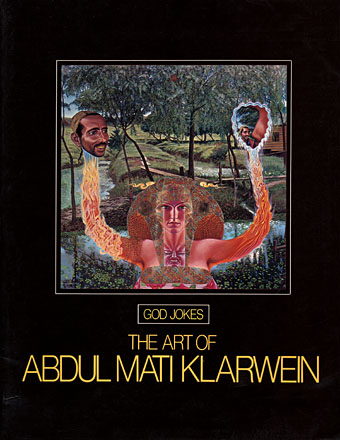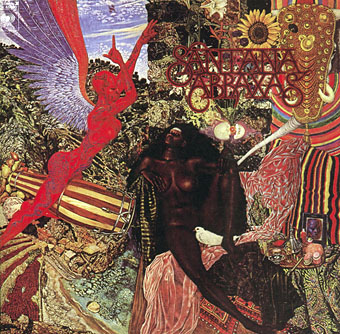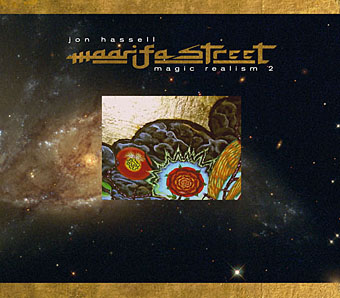
If book collecting is frequently a waiting game, some waiting periods can be longer than others. In the case of Mati Klarwein’s God Jokes, my patience and hope have sustained themselves for 28 years until I finally acquired a copy this Thursday afternoon. God Jokes was the second book of Mati Klarwein’s work, published by Harmony Books, New York, in 1976, a slim catalogue-style collection of his paintings, some of which were featured in the early issues of Omni magazine. In 1979 and 1980 God Jokes turned up in a chain of UK remainder shops and for a while it seemed like everyone I knew owned a copy which possibly explains my unaccountable decision to avoid buying one myself. As the years passed and I became increasingly enamoured with Mati Klarwein’s work I came to regret that decision, not least because the book seemed to disappear completely. Copies have turned up since on Abe.com but at bizarrely inflated prices (£50 for a 56-page art book?!). I paid £4.99; patience sometimes pays off.
Abraxas by Santana.
Mati Klarwein’s work has been most visible via the album sleeves of the Sixties and Seventies which borrowed his pictures for their covers. Chief among these is one of the best Santana albums, Abraxas (1970), which used his stunning 1961 painting The Annunciation (and a lettering design by Robert Venosa), and one of all-time favourite albums, the Miles Davis masterpiece Bitches Brew (1970). Miles Davis was a great Klarwein enthusiast for a while and commissioned new work for his Live-Evil album in 1971.

Live-Evil by Miles Davis.
It’s not necessary to go into detail describing Mati Klarwein’s work when you can go to the web gallery maintained by his family and feast your eyes there. Klarwein is one of the few 20th century artists to have taken Salvador Dalí’s photo-realist painting style and make of it something unique to himself; his work is always immediately recognisable. That this work is still known mainly for its illustrative connections tells you more about the iniquities of the art world than it does about the value of the paintings as works of art.
The most curious thing about having to wait so long to find a copy of God Jokes was that I ended up working with a picture of Mati Klarwein’s three years before I found the book; I would have expected to find the book one day but the latter eventuality was far less predictable. In 2005 Jon Hassell asked me to design his new CD, Maarifa Street, and Jon was keen to use a tiny video detail he made of a huge and incredible Klarwein painting, Crucifixion (1963–65). The detail is the rectangle in the centre of the cover, juxtaposed against some Hubble galaxies: the very small against the very large. We used the painting itself and further details inside the digipak. Jon was another of those who used Klarwein’s art for his album sleeves (for Earthquake Island, Dream Theory in Malaya and Aka-Darbari-Java/Magic Realism) and the two men became great friends as a result.
Crucifixion by Mati Klarwein.
Jon Hassell writes about Bitches Brew—and Mati Klarwein’s sleeve art—here. His site also includes a 1998 Mati Klarwein interview from The Wire in which the painter discusses his life and work. If you want a copy of God Jokes for yourself, be prepared to wait…or pay over the odds.
Elsewhere on { feuilleton }
• The fantastic art archive
Elsewhere on { feuilleton }
• The album covers archive
Previously on { feuilleton }
• Ballantine Adult Fantasy covers
• Visions and the art of Nick Hyde
• The poster art of Marian Zazeela




John
When I was at Pratt Institute I came across Santana’s album in the campus bookstore and brought the album solely because of the cover. I met Mati when he was living tin New York back in the early 1970’s.
At the time I was a great admired of the Austrian artist Ernst Fuchs and had corresponded with him regularly. He had his first one man show at the now defunct Aberbach Gallery on Madison Avenue. After the opening, Fuchs he took a few of his disciples to see his friend and admirer Mati [who used Fuchs’s complex oil and tempera technique] who lived around the corner on 78th Street. Mati was a tall, very thin, taciturn man completely consumed by his painting.
I was able to see many of his paintings as well as the completely assemble “Temple” to which the “Santana” paintings was part. It might be of interest to note that a lot of his paintings were done from elaborate colleges of photographs which were then translated in the oil-tempera technique. I always felt that his work was very un-even with some masterpieces such as his visionary landscapes and some rather pedestrian portraits & goofy monsters. However, like most serious painting; his work is much better in person and not severed well in reproduction.
I picked up a copy of the “Milk and Honey” book when it was first published at the wonderful 8th Street Bookstore. I think it was $4.00 or $5.00. Someone had a copy listed on ABE Books for 6 or 7 hundred bucks.
Thanks Richard, that’s fascinating to know about his working methods. I’ve often described this kind of approach as “painted collage” since it’s an approach I’ve tried myself in the past. It doesn’t surprise me that he was obsessed with his painting, there’s no way of producing such a body of detailed work without really dedicating yourself to it day after day, year after year.
The Aleph Sanctuary that you mention is featured in the final pages of God Jokes. I saw a recreated version at the 2005 Summer of Love exhibition in Liverpool; they also had a large painting of his on display (I forget the title although it’s in the catalogue), the only original work I’ve seen. The Sanctuary was a disappointment since all the “paintings” within were represented by blurry reproductions. It must have been quite something in its original state.
Of the four first Santana Band albums, I consider ‘Abraxas’ as the weakest.
But Klarwein’s cover is something else, entirely. It should have been featured on the group’s first album, in my humble opinion.
As for that black Madonna…good Lord!
(I wish I was that little white dove…!).
Dear John, I noticed a blog on nov 08 from Richard Sica, re: Mati. I was at the show at Auberbach Gallery and went with Fuchs to see Mati’s temple. It was amazing. I am trying to reach Richard Sica as I own 3 of his works an they will be part of a museum Visionary Art Show wich I am curating and will also include Mati and Fuchs among others.The firt show will be in Mobile Alabama in 2010.
If there is anyway to get in touch with Richard Sica could you please forward him my email and or website? Thanks
Hi Bridget. I’ve sent you an email.
The Annunciation on Santana Abraxas have a mind-blowing effect when I first saw it.I bought this album for its detailed art.But I’m sad that this great artist have gone and may God bless his soul.